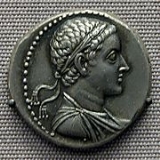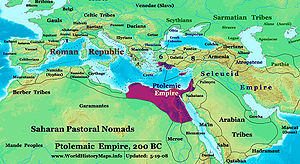
Ptolemy V Epiphanes
Encyclopedia
Ptolemy V Epiphanes son of Ptolemy IV Philopator and Arsinoe III of Egypt
, was the fifth ruler of the Ptolemaic dynasty
. He became ruler at the age of five, and under a series of regents the kingdom was paralyzed.
and Sosibius
, fearing that Arsinoe would secure the regency had her murdered before she heard of her husband's death, which secured the regency for themselves. In 202 BC
however Tlepolemus
, the general in charge of Pelusium
, put himself at the head of a revolt. Once Epiphanes was in the hands of Tlepolemus he was persuaded to give a sign that the killers of his mother should be killed. According to Bevan the child king's consent was given more from fear than anything else and Agathocles along with several of his supporters being killed by the Alexandrian mob.
and Philip V of Macedon
made a pact to divide the Ptolemaic possessions overseas. Philip seized several islands and places in Caria
and Thrace
, whilst the Battle of Panium
(198 BC
) definitely transferred Coele-Syria
, including Judea
, from the Ptolemies to the Seleucids.
Antiochus after this concluded peace, giving his own daughter Cleopatra I to Epiphanes to marry (193
–192 BC
). Nevertheless, when war broke out between Antiochus and Rome
, Egypt ranged itself with the latter power. Epiphanes in manhood was remarkable as a passionate sportsman; he excelled in athletic exercises and the chase.

Lycopolis was held by the forces of Ankmachis, (also known as Chaonnophris) the secessionist pharaoh of Upper Egypt, but was forced to withdraw to Thebes. The war between North and South continued until 185 BC
with the arrest of Ankmachis by Ptolemaic General Conanus.
In 183 BC
/184 BC
The rebels in Lower Egypt surrendered on the basis of terms that Epiphanes had personally promised to honour. However, showing himself in the opinion of Bevan treacherous and vindictive he had them put to death in a cruel manner.
The Rosetta Stone
, "basically a tax concession," was statement of thanks to the Egyptian priesthood for help during the crisis.
(181
–145 BC
), succeeded as an infant under the regency of his mother Cleopatra the Syrian
. Her death was followed by a rupture between the Ptolemaic
and Seleucid
courts, on the old question of Coele-Syria.
Arsinoe III of Egypt
Arsinoe III was Queen of Egypt . She was a daughter of Ptolemy III and Berenice II.Between late October and early November 220 BC she was married to her brother, Ptolemy IV. She took active part in the government of the country, at least in the measure that it was tolerated by the all-powerful...
, was the fifth ruler of the Ptolemaic dynasty
Ptolemaic dynasty
The Ptolemaic dynasty, was a Macedonian Greek royal family which ruled the Ptolemaic Empire in Egypt during the Hellenistic period. Their rule lasted for 275 years, from 305 BC to 30 BC...
. He became ruler at the age of five, and under a series of regents the kingdom was paralyzed.
Regency infighting
Ptolemy Epiphanes was only a small boy when his father, Ptolemy Philopator, died. The two leading favorites of Philopator, AgathoclesAgathocles of Egypt
Agathocles was a Ptolemaic minister and together with his sister Agathoclea were very close to Egyptian Greek Pharaoh Ptolemy IV Philopator who reigned 221 BC–205 BC....
and Sosibius
Sosibius
Sosibius was the chief minister of Ptolemy Philopator , king of Egypt. Nothing is known of his origin or parentage, though he may have been a son of Sosibius of Tarentum; nor have we any account of the means by which he rose to power; but we find him immediately after the accession of Ptolemy ,...
, fearing that Arsinoe would secure the regency had her murdered before she heard of her husband's death, which secured the regency for themselves. In 202 BC
202 BC
Year 202 BC was a year of the pre-Julian Roman calendar. At the time it was known as the Year of the Consulship of Geminus and Nero...
however Tlepolemus
Tlepolemus (regent of Egypt)
Tlepolemus was regent of Egypt in the Ptolemaic period under the reign of the boy-king Ptolemy V. He was briefly prominent at the end of the 3rd century BC; his dates of birth and death are not known....
, the general in charge of Pelusium
Pelusium
Pelusium was a city in the eastern extremes of Egypt's Nile Delta, 30 km to the southeast of the modern Port Said. Alternative names include Sena and Per-Amun , Pelousion , Sin , Seyân , and Tell el-Farama...
, put himself at the head of a revolt. Once Epiphanes was in the hands of Tlepolemus he was persuaded to give a sign that the killers of his mother should be killed. According to Bevan the child king's consent was given more from fear than anything else and Agathocles along with several of his supporters being killed by the Alexandrian mob.
War with Egypt and Macedonia
Antiochus III the GreatAntiochus III the Great
Antiochus III the Great Seleucid Greek king who became the 6th ruler of the Seleucid Empire as a youth of about eighteen in 223 BC. Antiochus was an ambitious ruler who ruled over Greater Syria and western Asia towards the end of the 3rd century BC...
and Philip V of Macedon
Philip V of Macedon
Philip V was King of Macedon from 221 BC to 179 BC. Philip's reign was principally marked by an unsuccessful struggle with the emerging power of Rome. Philip was attractive and charismatic as a young man...
made a pact to divide the Ptolemaic possessions overseas. Philip seized several islands and places in Caria
Caria
Caria was a region of western Anatolia extending along the coast from mid-Ionia south to Lycia and east to Phrygia. The Ionian and Dorian Greeks colonized the west of it and joined the Carian population in forming Greek-dominated states there...
and Thrace
Thrace
Thrace is a historical and geographic area in southeast Europe. As a geographical concept, Thrace designates a region bounded by the Balkan Mountains on the north, Rhodope Mountains and the Aegean Sea on the south, and by the Black Sea and the Sea of Marmara on the east...
, whilst the Battle of Panium
Battle of Panium
The Battle of Panium was fought in 200 BC between Seleucid and Ptolemaic forces as part of the Syrian Wars. The Seleucids were led by Antiochus III the Great, while the Ptolemaic army was led by Scopas of Aetolia. The Seleucids won the battle...
(198 BC
198 BC
Year 198 BC was a year of the pre-Julian Roman calendar. At the time it was known as the Year of the Consulship of Catus and Flamininus...
) definitely transferred Coele-Syria
Coele-Syria
Coele-Syria , or Cœle-Syria or Celesyria, traditionally given the meaning 'hollow' Syria, was the region of southern Syria disputed between the Seleucid dynasty and the Ptolemaic dynasty. Rather than limiting the Greek term to the Beqaa Valley of Lebanon, it is often used to cover the entire area...
, including Judea
Judea
Judea or Judæa was the name of the mountainous southern part of the historic Land of Israel from the 8th century BCE to the 2nd century CE, when Roman Judea was renamed Syria Palaestina following the Jewish Bar Kokhba revolt.-Etymology:The...
, from the Ptolemies to the Seleucids.
Antiochus after this concluded peace, giving his own daughter Cleopatra I to Epiphanes to marry (193
193 BC
Year 193 BC was a year of the pre-Julian Roman calendar. At the time it was known as the Year of the Consulship of Merula and Thermus...
–192 BC
192 BC
Year 192 BC was a year of the pre-Julian Roman calendar. At the time it was known as the Year of the Consulship of Flamininus and Ahenobarbus...
). Nevertheless, when war broke out between Antiochus and Rome
Roman Republic
The Roman Republic was the period of the ancient Roman civilization where the government operated as a republic. It began with the overthrow of the Roman monarchy, traditionally dated around 508 BC, and its replacement by a government headed by two consuls, elected annually by the citizens and...
, Egypt ranged itself with the latter power. Epiphanes in manhood was remarkable as a passionate sportsman; he excelled in athletic exercises and the chase.

The Egyptian Revolt
Great cruelty and treachery were displayed in the suppression of the native rebellion, and some accounts represent him as personally tyrannical. In 197 BC197 BC
Year 197 BC was a year of the pre-Julian Roman calendar. At the time it was known as the Year of the Consulship of Cethegus and Rufus...
Lycopolis was held by the forces of Ankmachis, (also known as Chaonnophris) the secessionist pharaoh of Upper Egypt, but was forced to withdraw to Thebes. The war between North and South continued until 185 BC
185 BC
Year 185 BC was a year of the pre-Julian Roman calendar. At the time it was known as the Year of the Consulship of Pulcher and Puditanus...
with the arrest of Ankmachis by Ptolemaic General Conanus.
In 183 BC
183 BC
Year 183 BC was a year of the pre-Julian Roman calendar. At the time it was known as the Year of the Consulship of Marcellus and Labeo...
/184 BC
184 BC
Year 184 BC was a year of the pre-Julian Roman calendar. At the time it was known as the Year of the Consulship of Pulcher and Licinus...
The rebels in Lower Egypt surrendered on the basis of terms that Epiphanes had personally promised to honour. However, showing himself in the opinion of Bevan treacherous and vindictive he had them put to death in a cruel manner.
The Rosetta Stone
Rosetta Stone
The Rosetta Stone is an ancient Egyptian granodiorite stele inscribed with a decree issued at Memphis in 196 BC on behalf of King Ptolemy V. The decree appears in three scripts: the upper text is Ancient Egyptian hieroglyphs, the middle portion Demotic script, and the lowest Ancient Greek...
, "basically a tax concession," was statement of thanks to the Egyptian priesthood for help during the crisis.
Succession
The elder of his two sons, Ptolemy VI PhilometorPtolemy VI Philometor
Ptolemy VI Philometor was a king of Egypt from the Ptolemaic period. He reigned from 180 to 145 BC....
(181
181 BC
Year 181 BC was a year of the pre-Julian Roman calendar. At the time it was known as the Year of the Consulship of Cethegus and Tamphilus...
–145 BC
145 BC
Year 145 BC was a year of the pre-Julian Roman calendar. At the time it was known as the Year of the Consulship of Ameilianus and Mancinus...
), succeeded as an infant under the regency of his mother Cleopatra the Syrian
Cleopatra I of Egypt
Cleopatra I Syra , c. 204–176 BC was a princess of the Seleucid Empire and by marriage, Queen of Ptolemaic Egypt.-Family:...
. Her death was followed by a rupture between the Ptolemaic
Ptolemaic dynasty
The Ptolemaic dynasty, was a Macedonian Greek royal family which ruled the Ptolemaic Empire in Egypt during the Hellenistic period. Their rule lasted for 275 years, from 305 BC to 30 BC...
and Seleucid
Seleucid dynasty
The Seleucid dynasty or the Seleucidae was a Greek Macedonian royal family, founded by Seleucus I Nicator , which ruled the Seleucid Kingdom centered in the Near East and regions of the Asian part of the earlier Achaemenid Persian Empire during the Hellenistic period.-History:Seleucus was an...
courts, on the old question of Coele-Syria.
External links
- Ptolemy V Epiphanes entry in historical sourcebook by Mahlon H. Smith

